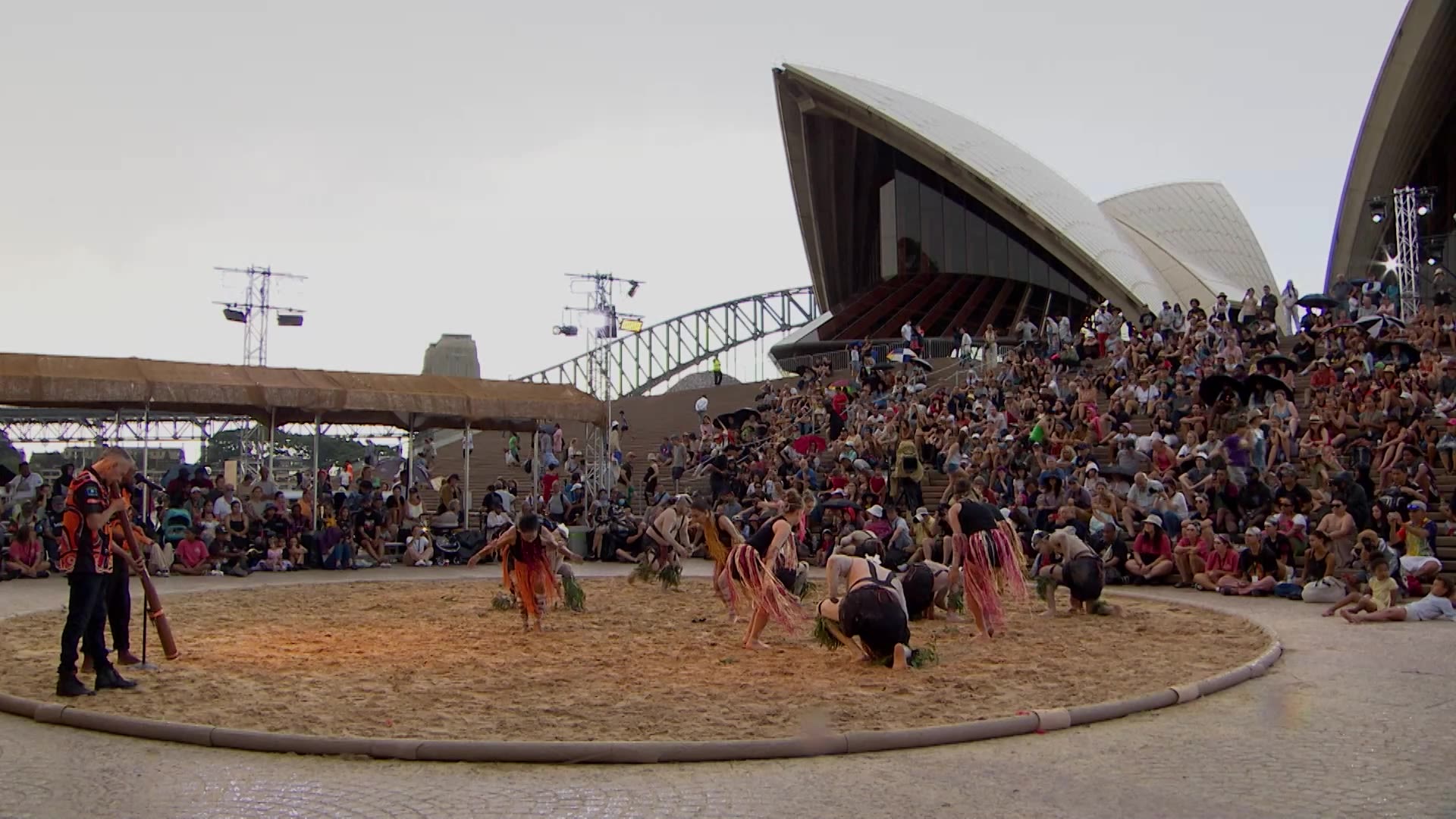A guide to
DanceRites
Your interactive handbook for the song and dance of
Australia’s first nations

The Sydney Opera House honours our First Nations by fostering a shared sense of belonging for all Australians, and we acknowledge the Gadigal people, traditional custodians of Tubowgule, the land on which the Opera House stands.
DanceRites — Australia’s First Nations dance competition — is our free, two-day celebration of Aboriginal and Torres Strait Island dance and cultures on the Sydney Opera House Forecourt.
DanceRites draws together performers representing nations from across the country. Groups travel to Sydney to showcase their unique cultures in one of the world’s most spectacular outdoor performance spaces: Bennelong Point. Formerly known as Tubowgule, Bennelong Point has been a meeting place for ritual celebration and dance for tens of thousands of years.
All Dance Groups have the opportunity to compete in two categories. Each group will present a Cultural Dance and Song cycle representing their local storytelling and language. A panel of First Nations dance practitioners will judge the entries on their technical dance presentation and engagement with language and culture.
Groups can also take part in a second optional category, presenting a ‘Wild Card’ dance.
This category can explore any dance style. This dance gives each group the opportunity to show off their style and techniques and to wow the audience.


Photo: Wayne Quilliam
Photo: Wayne Quilliam
Glossary
In Australian First Nations culture, language is more than just a means to communicate—it is inherently connected with the land and has deep spiritual significance. Each language came to the ancestral Aboriginal and Torres Strait Islander people during the Dreamtime; it's through these unique languages that communities maintain their connection with their ancestors, land, law and culture.
Below is a glossary of important words commonly used to discuss community life, connection to Country, song, dance and cultural lore. There are over 120 surviving Aboriginal and Torres Strait Islander languages in Australia, many with unique spellings and pronunciations. We’ve included common meanings for these words here along with audio samples voiced by Rhoda Roberts as a guide.
Place and land
Acknowledgement of Country
An Acknowledgement of Country is a way of recognising the traditional custodians' ongoing connection with the land, and of respecting Aboriginal culture and heritage. It can be given by persons of any background.
APY
Anangu Pitjantjatjara Yankunytjatjara (APY) lands.
Corroboree
An Eora word that has become part of Australia’s identity. It describes a place of ceremony and creative expression, a transformative gathering for New South Wales.
Country
A term used by Aboriginal people to refer to the land to which they belong and their place of Dreaming. Use of the word ‘country’ in Aboriginal language is much broader than standard English.
Dreaming
The Dreaming can be seen as an embodiment of Aboriginal creation which gives meaning to everything. It establishes the rules governing relationships between the people, the land and all things for Aboriginal people. The word itself has different meanings for different Aboriginal groups.
Homeland
Homelands (also territories, estates) are located on Aboriginal ancestral lands with cultural and spiritual significance to the First Nations people who live there. Complex connections to land include cultural, spiritual and environmental obligations, including obligations for the protection of sacred sites.
Indigenous
Native to a place or area, originating in and characterising a particular region or country, also including Aboriginal and Torres Strait Islander peoples. ‘Indigenous Australians’ is a term used to refer to the original inhabitants of Australia; it is always capitalised. Many Aboriginal people don’t like the term to be used to refer to them.
The mish
(“Missions”) Areas originally set up and governed by different religious denominations for Aboriginal people to live. Missions implemented government policies. Aboriginal people associate the term with trauma suffered from forced living conditions and abuse, rarely with positive memories.
Nation
A group of Aboriginal people who share an area of land, river and sea that is their traditional land. A nation has a number of clan or language groups.
Tjukurrpa
A central Australian word for Dreaming.
Photo: Wayne Quilliam
Photo: Wayne Quilliam
People and community
Aboriginal and First Nations
Usually refers to the First Peoples of mainland Australia and other countries such as Canada and Taiwan.
ATSI
Aboriginal and Torres Strait Islanders. Note that this abbreviation is not liked by many Aboriginal people due to its use in discriminating contexts.
Bossman, bosswoman
Connected to Dreaming and Traditional lores, they carry the knowledge for a particular song, dance and story of landscape ancestors.
Clan
Many Aboriginal nations are broken into clan groups with their own unique language, dialects and borders. Some clan members cannot marry one another under kinship.
Community
A community includes many important elements: country, family ties and shared experience. Community is about connection and belonging, and is central to Aboriginality. Aboriginal people may belong to more than one community.
Custodian
A person charged with maintaining and passing on particular elements of cultural significance including: knowledge, stories, song, dances, language, ritual and imagery.
Custodial Elder
The key go-to person within Aboriginal communities, respected and consulted due to their experience, wisdom, knowledge, background and insight. Often described as the ‘custodians of knowledge’ or the ‘libraries’ of a community. ‘Elder’ does not necessarily equate with age.
First Peoples
The term First Peoples is often used synonymously with 'Aboriginal people' or 'Indigenous people'.
Kinship
The importance of all relationships, and of being related to and belonging to the land. It’s a complex system that determines how people relate to each other and their roles, responsibilities and obligations in relation to one another, ceremonial business and land.
Mob
Colloquial term used by Aboriginal people to refer to a group of people they belong to.
Moiety systems
Skin names are divided into two groups, ‘sun side’ and ‘shade side’, and exist across regions. Most language groups also use a section or subsection system with four to eight skin names. An individual gains a skin name upon birth based on the skin names of their parents, to indicate the section / subsection that they belong to.
Torres Strait Islanders
Refers to the First Peoples of the Torres Strait region (as compared to the mainland people).
Photo: Wayne Quilliam
Photo: Wayne Quilliam
Song and dance
Bunggul
A north Australian (Yolngu) word describing a song with dance, or ceremonial dance performance.
Dhari
The distinctive traditional dance and ceremonial headdress of the Torres Strait. The dancer's headdress is the main symbol on the flag for the Torres Strait region and represents unity for the people.
Inma
In Anangu culture, the art of dance is reserved for a very small number of special events and is therefore rarely seen. This dance is called an ‘inma’. Every move and sound is rich with ancient meaning.
Warup
The Torres Strait Islands' traditional drum are used for celebrations, island dancing and singing. The drum is carved and hollowed from driftwood. Goanna skin is stretched over the drum and held in place with a split bamboo holding ring sealed with beeswax.
Yidaki
A family of hollow, wooden instruments connected to Yolngu Law and ceremony in song, dance, visual art and narrative. The word ‘didgeridoo’ is an introduced, generic term that lacks the significance and precision of the diverse names for this instrument.
Photo: Wayne Quilliam
Photo: Wayne Quilliam
Law and culture
Artefact
Any object made or modified by Aboriginal people, often stone tools or wooden objects. A group of artefacts (especially stone tools) located on the ground surface is referred to as ‘artefact scatter’.
Assimilation
A 19th century idea that Aboriginal people should become white, convert to Christianity and learn how to work and live as Europeans. From the 1930s assimilation became Australian government policy. With many living under what was known as the Aborigines Protection Act, in 1969 it became known as the Aborigines Act and was repealed in 1983.
Culture
The accepted and traditionally patterned ways of behaving, and a set of common understandings shared by members of a group or community. Includes land, language, spirituality, ways of living and working, artistic expression, relationships, and identity.
Customary law
Based on traditions and customs of a particular group in a specific region. Also referred to as ‘lore’.
Decolonisation
Describes the ending of colonisation and the liberation of those who were colonised. The process includes dismantling the colonial state and its laws. The ultimate goal is the self-determination of those who were colonised. Those pursuing decolonisation start by reconnecting with kin and country, and disengaging with the colonial system.
Language group
Language is linked to particular geographical areas. The term ‘language group’ is often used in preference to the term ‘tribe’, and many Aboriginal people identify themselves through their language group.
Lore
The learning and transmission of cultural heritage. See also: ‘customary law’.
Makarrata
Denotes a domestic treaty between the Commonwealth government and Aboriginal people. It comes from a word in the Yolngu language meaning coming together after a struggle, facing the facts of wrongs and living again in peace.
Message stick
A message stick is a form of communication used by groups entering other clan and nation boundaries. Message sticks were incised and carved passed between different clans and language groups to establish information and transmit messages and walk across country on invitation and safe passage.
Midden
Originally a Danish word, now used for a large heap of shell and other food remains left by Aboriginal people at camp sites which build up over an extended period of time. Middens are often found near rock platforms and in proximity of fresh water.
Songline
A songline (also known as a ‘Dreaming Track’ or ‘Trade Routes’ ) is a path across the land which marks the journey of creator-beings as they created the lakes, rivers, plants, land formations and living creatures during the Dreaming. Songlines are recorded in traditional songs, stories, dance, and painting.
Sorry Business
An English expression mostly adopted from mainland Aboriginal people to refer to a period of cultural practices and protocols associated with death. The most widespread ceremonies of Sorry Business are conducted around the bereavement and funerals for a deceased person.
Sovereignty
The ultimate power, authority or jurisdiction over a people and a territory. No other person, group, tribe or state can tell a sovereign entity what to do with its land or people. A sovereign entity can decide and administer its own laws, determine the use of its land and do pretty much as it pleases, free of external influence—within the limitations of international law. Sovereignty is a more precise term than ‘self-determination’.
Woomera
A wooden device used to throw spears. The woomera is held in one hand while the other hand places the butt of the spear on the woomera's hook. From the Dharug Language of Sydney and the Blue Mountains.
Acknowledgements
Global Goals Partner
Event Sponsor
Media Sponsor
The Sydney Opera House thanks Global Goals Partner Honeywell, Event Sponsor Sydney Harbour Federation Trust, Event Media Partner NITV and donors to DanceRites and its Travel Fund for their generous support of DanceRites 2024.
A very special thank you to Sydney Harbour Federation Trust for providing accommodation for dance groups on Cockatoo Island / Wareamah.
A very special thank you to Yuwaalarray artist Lucy Simpson for the creation of our DanceRites artwork.
Editors
Justin Tam, Dominic Ellis
Thanks to all past participants and performers
of DanceRites
Words
Rhoda Roberts, Francesca Hughes
Illustrations
Lucy Simpson
Campaign Creative
SOH Creative Studio
Audio engineering
Justin Tam, Jacob Burkett
Web design & development
Dominic Ellis, Justin Tam
Photography
Wayne Quilliam
With thanks
Susie Anderson, Hannah Worrall, Esther Crowley, Francesca Breen, Neil Simpson
Follow us on YouTube /sydneyoperahouse, Facebook at @sydneyoperahouse, Instagram at @sydneyoperahouse, and Twitter at @sydoperahouse








